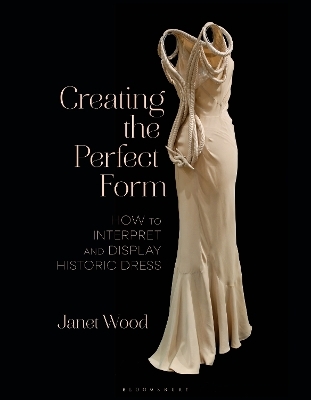
Creating the Perfect Form
Bloomsbury Visual Arts (Verlag)
978-1-350-32865-5 (ISBN)
Conservation and historic dress display specialist Janet Wood will help you answer all these questions. You'll learn how historic garments can be safely handled and shown to best effect, with insight into the characteristic features of each piece and how to translate them from the garment to a display support.
Concentrating on Western women's wear from 1750–1950, and with over 250 colour images, plus drawings and charts, you’ll learn how to interpret an individual garment’s display needs and create safe, appropriate display forms.
Janet Wood is a freelance consultant on large exhibitions in major museums and historic properties, including Chatsworth House and the Museum of London. She was previously a fashion designer working with Thea Porter, Monsoon and freelance (1971-90), and a textile conservator with Historic Royal Palaces (1992–2012).
Introduction
1. Assessing the Condition of a Garment
2. Date
Paintings
Cartoons
Fashion plates
Photographs
Newspapers, magazines and other literary sources
Books
Technical developments and dressmaking techniques
Fabrics
Alterations
Media
Summary
3. Garment Cut and its Relationship to Underwear
Research system
Corset timeline
18th century
1800 – 1820
1820 – 1830
1830 – 1840
1840 – 1850
1850 – 1860
1860 – 1870
1870 – 1890
1870 – 1880
1880 – 1890
1890 – 1900
1900 – 1910
1910 – 1920
1920s
1930s
1940s
1950s
Summary
4. Storyboards & Silhouettes
How to use storyboards to date a garment
Silhouette timeline
How to relate the construction of a garment to the timeline silhouettes
Summary
5. Measurements
Descriptions of the horizontal body measurements
Descriptions of the vertical body measurements
The importance of the relationship between garment measurements
Comparing garment measurements to a body, mannequin or bust form
Using a measurement chart
Tools for measuring
Tape measures and their uses
Measuring historic garments
Tips for accurate measuring
Summary
6. Selecting & Preparing a Mannequin or Bust Form
Guidelines
Bust form or mannequin
Preparing a bust form or mannequin
Tools for padding mannequins and bust forms
Applying polyester wadding
Bust form
Mannequin
Needles
Step-by-step process for customizing a bust form
Top covers
Summary
7. Patterns &Toiles
The straight grain
Locating the straight grain position on historic garments
Tools for taking a pattern from a garment
Three methods for creating patterns for toiles
Making a pattern for a toile
‘Join the dots’ method
‘Draping’ method
Tissue paper templates
Constructing the toile
Summary
8. Petticoats, Arms & Finishing Touches
Base petticoat
Base petticoat method
Net petticoats
Net petticoat method
18th century pannier petticoat
Top petticoats
Sleeve supports – Arms
Summary and finishing touches
Conclusion
Bibliography
Glossary
Garment measuring chart
Basic arm patterns
Padding diagram
| Erscheinungsdatum | 24.08.2024 |
|---|---|
| Zusatzinfo | 250 colour illus |
| Verlagsort | London |
| Sprache | englisch |
| Maße | 210 x 270 mm |
| Themenwelt | Kunst / Musik / Theater ► Design / Innenarchitektur / Mode |
| Kunst / Musik / Theater ► Kunstgeschichte / Kunststile | |
| Sachbuch/Ratgeber ► Gesundheit / Leben / Psychologie ► Lebenshilfe / Lebensführung | |
| Geisteswissenschaften ► Geschichte ► Hilfswissenschaften | |
| Sozialwissenschaften | |
| ISBN-10 | 1-350-32865-0 / 1350328650 |
| ISBN-13 | 978-1-350-32865-5 / 9781350328655 |
| Zustand | Neuware |
| Haben Sie eine Frage zum Produkt? |
aus dem Bereich


